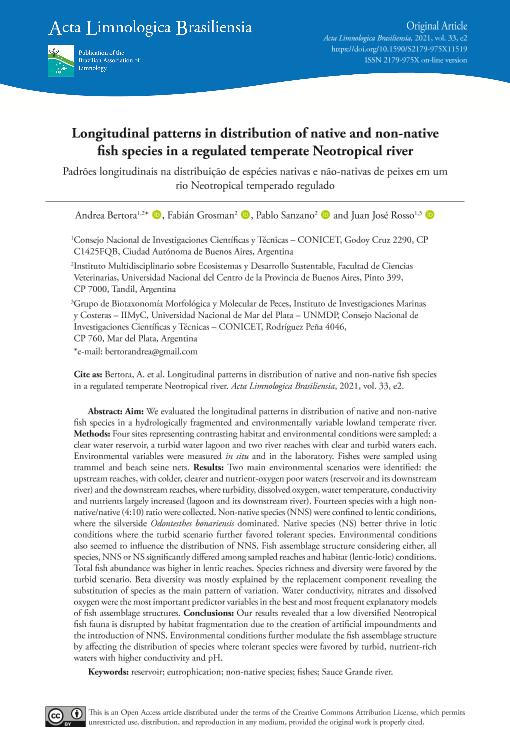Mostrar el registro sencillo del ítem
dc.contributor.author
Bertora, Andrea

dc.contributor.author
Grosman, Fabián
dc.contributor.author
Sanzano, Pablo Miguel

dc.contributor.author
Rosso, Juan Jose

dc.date.available
2022-08-04T20:13:42Z
dc.date.issued
2021-01
dc.identifier.citation
Bertora, Andrea; Grosman, Fabián; Sanzano, Pablo Miguel; Rosso, Juan Jose; Longitudinal patterns in distribution of native and non-native fish species in a regulated temperate Neotropical river; Associação Brasileira de Limnologia; Acta Limnologica Brasiliensia; 33; 1-2021; 1-20
dc.identifier.issn
0102-6712
dc.identifier.uri
http://hdl.handle.net/11336/164308
dc.description.abstract
Aim: We evaluated the longitudinal patterns in distribution of native and non-native fish species in a hydrologically fragmented and environmentally variable lowland temperate river. Methods: Four sites representing contrasting habitat and environmental conditions were sampled: a clear water reservoir, a turbid water lagoon and two river reaches with clear and turbid waters each. Environmental variables were measured in situ and in the laboratory. Fishes were sampled using trammel and beach seine nets. Results: Two main environmental scenarios were identified: the upstream reaches, with colder, clearer and nutrient-oxygen poor waters (reservoir and its downstream river) and the downstream reaches, where turbidity, dissolved oxygen, water temperature, conductivity and nutrients largely increased (lagoon and its downstream river). Fourteen species with a high non-native/native (4:10) ratio were collected. Non-native species (NNS) were confined to lentic conditions, where the silverside Odontesthes bonariensis dominated. Native species (NS) better thrive in lotic conditions where the turbid scenario further favored tolerant species. Environmental conditions also seemed to influence the distribution of NNS. Fish assemblage structure considering either, all species, NNS or NS significantly differed among sampled reaches and habitat (lentic-lotic) conditions. Total fish abundance was higher in lentic reaches. Species richness and diversity were favored by the turbid scenario. Beta diversity was mostly explained by the replacement component revealing the substitution of species as the main pattern of variation. Water conductivity, nitrates and dissolved oxygen were the most important predictor variables in the best and most frequent explanatory models of fish assemblage structures. Conclusions: Our results revealed that a low diversified Neotropical fish fauna is disrupted by habitat fragmentation due to the creation of artificial impoundments and the introduction of NNS. Environmental conditions further modulate the fish assemblage structure by affecting the distribution of species where tolerant species were favored by turbid, nutrient-rich waters with higher conductivity and pH.
dc.format
application/pdf
dc.language.iso
eng
dc.publisher
Associação Brasileira de Limnologia
dc.rights
info:eu-repo/semantics/openAccess
dc.rights.uri
https://creativecommons.org/licenses/by/2.5/ar/
dc.subject
EUTROPHICATION
dc.subject
FISHES
dc.subject
NON-NATIVE SPECIES
dc.subject
RESERVOIR
dc.subject
SAUCE GRANDE RIVER
dc.subject.classification
Ecología

dc.subject.classification
Ciencias Biológicas

dc.subject.classification
CIENCIAS NATURALES Y EXACTAS

dc.title
Longitudinal patterns in distribution of native and non-native fish species in a regulated temperate Neotropical river
dc.title
Padrões longitudinais na distribuição de espécies nativas e não-nativas de peixes em um rio Neotropical temperado regulado
dc.type
info:eu-repo/semantics/article
dc.type
info:ar-repo/semantics/artículo
dc.type
info:eu-repo/semantics/publishedVersion
dc.date.updated
2022-08-04T15:06:25Z
dc.identifier.eissn
2179-975X
dc.journal.volume
33
dc.journal.pagination
1-20
dc.journal.pais
Brasil

dc.description.fil
Fil: Bertora, Andrea. Consejo Nacional de Investigaciones Científicas y Técnicas. Centro Científico Tecnológico Conicet - Tandil; Argentina. Universidad Nacional del Centro de la Provincia de Buenos Aires. Facultad de Ciencias Exactas. Instituto Multidisciplinario de Ecosistemas y Desarrollo Sustentable; Argentina
dc.description.fil
Fil: Grosman, Fabián. Universidad Nacional del Centro de la Provincia de Buenos Aires. Facultad de Ciencias Exactas. Instituto Multidisciplinario de Ecosistemas y Desarrollo Sustentable; Argentina
dc.description.fil
Fil: Sanzano, Pablo Miguel. Universidad Nacional del Centro de la Provincia de Buenos Aires. Facultad de Ciencias Exactas. Instituto Multidisciplinario de Ecosistemas y Desarrollo Sustentable; Argentina
dc.description.fil
Fil: Rosso, Juan Jose. Consejo Nacional de Investigaciones Científicas y Técnicas. Centro Científico Tecnológico Conicet - Mar del Plata. Instituto de Investigaciones Marinas y Costeras. Universidad Nacional de Mar del Plata. Facultad de Ciencias Exactas y Naturales. Instituto de Investigaciones Marinas y Costeras; Argentina
dc.journal.title
Acta Limnologica Brasiliensia

dc.relation.alternativeid
info:eu-repo/semantics/altIdentifier/url/https://www.scielo.br/j/alb/a/ZFXgm8ZQr9yz3Nxc8sYTT4s/?lang=en
dc.relation.alternativeid
info:eu-repo/semantics/altIdentifier/doi/https://doi.org/10.1590/S2179-975X11519
Archivos asociados
